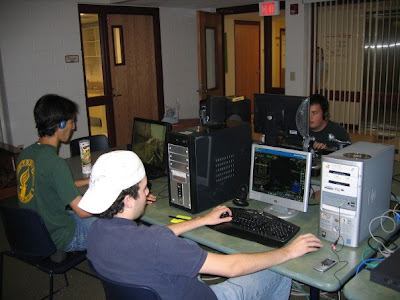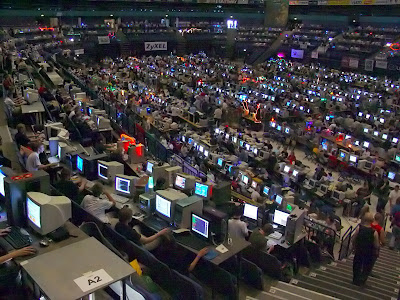I've been going to LAN Parties for a while now and I want to host one, Ok? Now what?
Hosting a LAN Party is a ton of fun. Its nice to meet gamers just like and make new friends. You will learn a lot about computers, networking, marketing, people skills and more, some of which you can learn how to do in this guide.
The bad news? Hosting a LAN Party is lot of work.
If your planning a LAN Party be prepared to:
- Get stressed Out
- Put your own money into it.
- Not make any money from it.
- Work more than you play.
- Deal with crazy people.
Truthfully, Its a LOT of work but for me, the rewards out way all of this. I find it fun to make new friends, help people fix their computers and see everyone else having fun. What you get out of it could be different.
Size is Everything.A lot of what you have to do to host a LAN Party depends on the size. A small party can be quick and easy but a major event could take months of planning. They do all have somethings in common, they all need tables, chairs, extension cords, power strips and some networking equipment. If you are new at the whole LAN Party thing, I suggest you start small and slowing increase the size of your event. Below is a summery of what it take to put on each size event.
Garage LAN Party (3+)A Garage LAN Party is one that you host in your house/apartment/dorm room for a few friends. It doesn't take much time to setup and don't require much preplanning. Guests don't expect much either. Messy cords and lack of organization are normal. Everyone is here just to hang out and have fun. The cost is minimal because nothing big has to be bought, you only need a couple of extension cords and power strips. The network is simple and is probably already in place a small switch may be the only item needed. Tables and chairs can be moved from other rooms for people to use. Food and drinks may be as simple as everyone chipping in some money to get a pizza delivered. Cost- each event: $0, one-time: $80- $150.
Small LAN Party (10+)While bigger than a garage LAN Party, this still a small event, you'll probably have a few new people coming. You will have to do some planning before the event to get everything going and a few volunteers to help with check in. If you have a friend that can help you, you'll do even better. You will need to keep some form order to keep thing under control. You will need to have a bigger space to host this party. If your house/ apartment is small you may have to see if you can checkout a community room or the like (See the Location Guide). With more guests comes the need for more you have equipment you have to buy and setup. Table and chairs may needed to be rented to giver every one a space. Electrical circuits need to be looked at to make sure they aren't overloaded (See the
Electrical Guide) . The network also needs to be setup beforehand, you need a nice table switch and a router that can handle the extra load (See the
Network Guide). You need to plan food and drinks to fuel your guests gaming. Charging a small fee for this isn't unreasonable. A registration system and a wavier is a good idea to prevent any legal problems. With 10+ people, you're more like to get a sponsor that will send some free swag for you give out. (Don't expect any hardware). Cost- each event: $100, one-time: $150- $300.
Medium LAN Party (50+)A medium size event needs to one or two dedicated people to plan and organize it and several volunteers to help at the event. Guests expect a lot from an event of this size and you need to be prepared. First you need to decided on a budget to keep costs from getting out of control. Then you need to pick a location to rent (See
Location Guide) along with tables and chairs. Electrical requirements soon become your primary concern and must be calculated and if the location can't provide enough, a generator may need to be rented (See the
Electrical Guide). The network must be carefully planned in order make sure it can handle the number guests your planning for. You will need to have multiple switches, servers and other network equipment to keep the gaming going(See the
Network Guide). Food and drinks need to be bought and a distribution system decided on (See Food/Drink Guide). Advertising needs to start early in order to fill all of the seats. You will need registration system and volunteers trained to run it. With so many guests you need to consider taking security measures like making sure computers are labeled with their owners information and checked in and out of the room to keep items from getting stolen. However a benefit of this many guests means more companies may be willing to sponsor your event and you may even get some hardware for prizes. Cost- each event: $300-$500, one-time: $500- $800.
Large LAN Party (100+)A LAN Party of this size is outside of the scope of this guide and anyone in their right mind would already have the experience and know how to put one on.
A Little About Me
If you've already read the introduction to this blog you probably already know all of this.
I am a student in the Masters of Architecture Program at the University of South Florida and I am a Co-chair of an Event put on by the USF he Residence Hall Association called LAN-O-THON.
I have been a fan of LAN Parties for many years but it wasn't until I got to USF did I get into organizing any. Over my last two years there, I have hosted more than 8 events ranging from 3 people all the way to 150 (however, the BYOC was only 30 seats). For our next event, I'm planning to have a BYOC of 50+ seats.
My favorite LAN party is one where I can have fun and hang out and play a few games. Do I want to play computer games for 10 hours straight- NO! I like to play a little, chat a little, help a little. I'm not fond of LAN parties where the main attraction is one big tournament where you wait for hours till its your turn to compete.
So for LAN-O-THON v4.0 I want the event first and foremost to be a fun event to hang out and have fun. I will be hosting several tournaments (to be discussed in a future article) to challenge and entertain people through out the night but it won't take over the event. There will be multiple game servers going for a variety of games. I hope with 50 people in attendance that we will be able to sustain game play on several servers all night long. I want to attract as many people as possible to attend so there has to be something for everyone.
But Don't take my word for ItI suggest you read more than just my site before running off and organizing your first event. So have a look at some of these other guides.
- Toms Hardware LAN How To: Part One, Two, and Three
- LANparty.com Guide (The networking part is outdated.
Did I leave something out? That's what the comment box is for.
Continue on to
Location, Location, Location
























